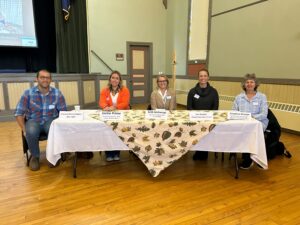One Region’s Strategy to Increase Child Care Capacity
by Ellen Taetzsch
Imagine you are a parent who just had a child and it is time to go back to work but there are no slots open at child cares near your home or your work. What would you do? Imagine you have the perfect child care and you are so happy to continue sending your child there. One day, the teacher tells you that they can’t find enough qualified staff to keep both classrooms open and that means that some children’s care needs might not be met, they are having to close down a classroom. This is an all too common reality that families face in Vermont.
What do the number say?
In Vermont, 84% of infants and 64% of toddlers likely to need care do not have access to high quality care according to the Stalled at the Start Report released by Let’s Grow Kids in February 2018. In Orange County these numbers are 89% and 72% and in Windsor County they are 76% and 44%, see table below. The Northern Windsor and Orange County Regional Building Bright Futures Council, which comprises some of the towns in these two counties, recognized this as a challenge, not only in our region, but across the state.
|
|
Infants likely to need care without access to regulated care | Infants likely to need care without access to high quality care | Toddlers likely to need care without access to regulated care |
Toddlers likely to need care without access to high quality care |
| Vermont | 65% | 84% | 23% | 64% |
| Orange County | 77% | 89% | 47% | 72% |
| Windsor County | 62% | 76% | 15% | 44% |
This report also notes that between 2016 and 2018 statewide the desired capacity of regulated early care and learning providers in Vermont has decreased by 8% for infants and 6% for toddlers, see chart below.
Not only has demand increased for infants and toddlers, but also among children in pre-kindergarten. Publicly funded pre-kindergarten education (Act 166 of 2014) has increased access to high quality early learning environments for 3- and 4-year-olds in Vermont. According to the Vermont Agency of Education Preliminary Report of April 2018, enrollment in Prekindergarten programs increased 22% between 2015 and 2016.
Discussions in the Region:
As we discussed why capacity has decreased in the past few years when the need for child care is so great, we noted many factors. However, one of the main factors that providers mentioned was not being able to find staff, let alone qualified staff. The council acknowledged that Technical and Career Centers and colleges, some of whom closed early childhood training program due to low enrollment, are now rebuilding training programs and trying to recruit students. Unfortunately, even with these efforts, the workforce hasn’t kept up with the demand. This has had consequences. In the coming year, some area early childhood programs may have to close classrooms because they can’t find qualified teachers. This is a reality for a few programs in our region. Providers have simply run out of options.
What can we do?
 The shortage of qualified staff has been a challenge that the Northern Windsor and Orange Regional Council has been wrestling with. The council decided to host its first ever Early Childhood Job Fair as a first step to raise awareness of both the need for staff in the region, as well as the variety of careers that one can have in the early childhood field. The purpose of this event was twofold:
The shortage of qualified staff has been a challenge that the Northern Windsor and Orange Regional Council has been wrestling with. The council decided to host its first ever Early Childhood Job Fair as a first step to raise awareness of both the need for staff in the region, as well as the variety of careers that one can have in the early childhood field. The purpose of this event was twofold:
- To provide a place for early childhood organizations to advertise positions and meet potential candidates.
- To increase knowledge for those interested in entering the early childhood field on the types of jobs available and resources available to help meet requirements.
We were able to partner with the Community College of Vermont Upper Valley (CCV) and hold the event at their campus. This helped us to create connections between members of the early childhood field and CCV, which is hosting many professional development opportunities and provides a pathway for those interested in entering the field.
We reached out to providers through a variety of means. We had 19 different organizations wanting to have a table for the Job Fair. These included Parent Child Centers, Community Colleges in both New Hampshire and Vermont, child cares, nursery schools, after school programs, preschools and Northern Lights.
This event supported both those seasoned in the field as well as individuals wanting to learn more information about what it is like to work in the field and how to get started. We had a wide age range of those who attended including a recent high school graduate, an individual looking for a career change, and those excited about the opportunity for more flexible schedules.
One interesting thing to note is that all those who had tables were given a survey and asked “what makes hiring people a challenge?” Each participant who completed surveys responded finding qualified candidates a challenge. We also surveyed job seekers who attended, asking “What makes a career in early care and education difficult for you?” Each of these surveys submitted responded “I don’t have the qualifications”. How do we support the efforts of training programs for those wishing to enter the field? How do we connect those with qualifications to programs looking to hire?
Statewide Initiatives:
This issue is a statewide issue. There are many different organizations working to try and support families with finding the kind of child care that they need. Two of these include: the Early Childhood Higher Education Consortium, which has been convening institutes of higher education for the last few years to improve pathways to credentials, degrees, and licensure for the early childhood workforce; and Vermont Birth to Five Make Way for Kids Grants supporting program expansion and start up as well as work force development. Building Bright Futures is also working with public and private partners on a Vermont Household Demand for Early Care and Education Study to better understand the current need for childcare in the state.
While these statewide initiatives are occurring, the job fair was Northern Windsor and Orange County Regional Council’s way of raising awareness, continuing the conversation, and recruiting individuals to enter the field in our region. The work is not done, but the fair was an important step in the right direction.







